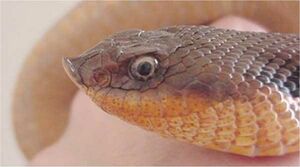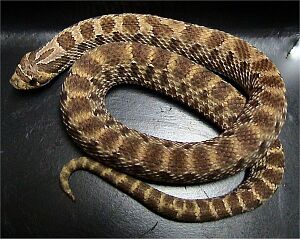حوفث
| حوفث | |
|---|---|

| |
| الحوفث الشرقي (H. platirhinos) | |
| التصنيف العلمي | |
| أصنوفة غير معروفة (أصلحها): | Heterodon |
الحوفث (إنگليزية: Heterodon)، هو جنس من الثعابين الحنشيات الغير ضارة موطنها أمريكا الشمالية.[1] وهي ثعابين ممتلئة الجسم ذات أنف مقلوب وربما تشتهر بظهور التهديدات المميزة الخاصة بها. يضم هذا الجنس ثلاثة أنواع معترف بها حالياً.[2] عادة ما تشهر الثعابين في هذا الجنس باسم الثعابين مدببة الأنف، [3] ثعابين أمريكا الشمالية مدببة الانف،[2] وبالعامية الأفاعي المنتفخة[بحاجة لمصدر] (على الرغم من أنه لا ينبغي الخلط بينها وبين الأفاعي الأفريقية السامة من جنس Bitis).
. . . . . . . . . . . . . . . . . . . . . . . . . . . . . . . . . . . . . . . . . . . . . . . . . . . . . . . . . . . . . . . . . . . . . . . . . . . . . . . . . . . . . . . . . . . . . . . . . . . . . . . . . . . . . . . . . . . . . . . . . . . . . . . . . . . . . . . . . . . . . . . . . . . . . . . . . . . . . . . . . . . . . . . .
الوصف
Adults grow to 30–120 cm (12–47 in) in total length. The body is stout and the head is slightly distinct from the neck. The latter is expandable, the anterior ribs being capable of spreading to flatten that portion of the body, similar to a cobra. The tail is short and the anal scale divided. The dorsal scales are keeled with apical pits in 23-25 rows. The rostral scale is projecting, upturned, recurved and keeled dorsally. There are usually 1-20 accessory scales (azygous) that separate the internasals and the prefrontals. A subocular ring is present with 8-12 ocular scales. There are 7-8 upper labials and 9-13 lower labials. The ventrals number 114-152 and the subcaudals 27-60.[3]
The color pattern is extremely variable. H. nasicus tends to be sandy-colored with black and white markings, while H. platirhinos varies from reds, greens, oranges, browns, to black depending on locality. They are sometimes blotched and sometimes solid-colored.
Members of this genus have enlarged rear maxillary teeth, two on each side, and possess a slightly toxic saliva. In a few cases involving bites from H. nasicus, the symptoms reported have ranged from none at all to mild tingling, swelling and itchy skin. Nevertheless, they are generally considered to be very harmless to humans.[4]
Hognose snakes' most distinguishing characteristic is their upturned snout, which is believed to aid in digging in sandy soils.
السلوك
When threatened, the hognose snake will flatten its neck and raise its head off the ground, similar to a cobra, and hiss. It may sometimes feign strikes, but is extremely reluctant to bite. This behavior has earned the hognose snake several nicknames, such as "blowing adder", "flathead", "spreading adder", or "hissing adder". If this threat display does not work to deter a would-be predator, the hognose snake will often roll onto its back and play dead with its mouth open and tongue lolling, going as far as to emit a foul musk from the cloaca. Emission of cloacal musk is considerably less likely than in many other species. If the snake is rolled upright while in this state, it will often roll over again as if to insist that it is really dead.
Unfortunately due to their appearance and impressive defensive display, hognose snakes are commonly mistaken to be copperheads and subsequently killed. This is especially true in the southeastern regions of the United States, where copperheads are especially prevalent by comparison to other areas it shares with the hognose.[5]
التغذية
يتألف الجزء الأكبر من النظام الغذائي للحوفث من القوارض والسحالي، باستثناء الحوفث الشرقي، وهو متخصص في التغذية على العلاجيم، ولديه مناعة ضد السموم التي تفرزها العلاجيم.
في الأسر
تظهر ثعابين الحوفث بشكل متكرر في تجارة الحيوانات الأليفة الغريبة. أكثرها سهولة في العناية الحوفث الغربي. أما الحوفث الشرقي فهو موجود بشكل شائع، لكن متطلباته الغذائية يمكن أن تمثل صعوبة لبعض المربين.
الأنواع
| النوع[2] | التسمية[2] | تحت النوع*[2] | الاسم الشائع[2] | النطاق الجغرافي[6] |
|---|---|---|---|---|
| H. kennerlyi | كنيكوت، 1860 | 0 | الحوفث المكسيكي | جنوب تكساس إلى شمال المكسيك. يعتبر في بعض الأحيان نوعاً فرعياً من الحنفش الغربي. |
| H. nasicus | بيرد وگيرارد، 1852 | 2 (sometimes elevated to species status, based on two scale characters)[7] | Western hognose snake | جنوب شرق ألبرتا وجنوب غرب مانيتوبا في كندا، جنوب إلى جنوب شرق أريزونا وتكساس في الولايات المتحدة. أعداد متفرقة في منسوتا، وسكنسن، آيوا، إلينوي، مزوري، وأركنساس |
| H. platirhinos | لاتريل، 1801 | 0 | الحوفث الشرقي | الولايات المتحدة: شرق وسط منسوتا إلى أقصى الجنوب نيو هامپشير، جنوبًا إلى جنوب فلوريدا وغربًا إلى شرق تكساس وغرب كانساس. |
| H. simus | (لينايوس، 1766) | 0 | الحوفث الجنوبي | الولايات المتحدة: من السهول الساحلية في جنوب شرق كارولينا الجنوبية وجنوبًا إلى بحيرة أوكيشوبي في فلوريدا ومن الغرب إلى جنوب شرق مسيسيپي. |
* لا يشمل تحت الأنواع المرشحة
المصادر
- ^ Platt, Dwight R. 1983. Heterodon. Catalogue of American Amphibians and Reptiles. Society for the Study of Amphibians and Reptiles, 351: 1-2.
- ^ أ ب ت ث ج ح Heterodon (TSN {{{ID}}}). Integrated Taxonomic Information System.
- ^ أ ب Wright AH, Wright AA. 1957. Handbook of Snakes of the United States and Canada. Ithaca and London: Comstock Publishing Associates. (7th printing, 1985). 1,105 pp. (in 2 volumes) ISBN 0-8014-0463-0. (Genus Heterodon, p. 296 + Figure 25 on p. 81 + Map 28 on p. 298.)
- ^ Are Hognosed Snakes Venomous? Archived 2006-11-07 at the Wayback Machine at Hognose.com. Accessed 2 August 2008.
- ^ It's not a copperhead! Archived 2009-09-09 at the Wayback Machine at southernzombie.com Archived 2009-09-08 at the Wayback Machine. Accessed 31 August 2009.
- ^ Behler JL, King FW. 1979. The Audubon Society Field Guide to North American Reptiles and Amphibians. New York: Alfred A. Knopf. 743 pp. LCCCN 79-2217. ISBN 0-394-50824-6.
- ^ Smith, H. M.; Chiszar, D.; Eckerman, C. M.; Walley, H. D. (2003). "The taxonomic status of the Mexican Hognose Snake Heterodon kennerlyi Kennicott (1860)" (PDF). Journal of Kansas Herpetology. 5: 17–20. Archived from the original (PDF) on 2018-05-16. Retrieved 2018-05-15.
وصلات خارجية
قراءات إضافية
- Goin, Coleman J.; Olive B. Goin; George R. Zug. (1978). Introduction to Herpetology, Third Edition. San Francisco: W.H. Freeman. xi + 378 pp. ISBN 0-7167-0020-4. (Heterodon, pp. 149, 167, 328-329.)
- Latreille, P.A. In Sonnini, C.S. and P.A. Latreille. (1801). Histoire naturelle des reptiles, avec figures dessinées d'apres nature; Tome IV. Seconde Partie. Serpens. Paris: Crapelet. 410 pp. (Genus Heterodon, p. 32.)
- Schmidt, K.P., and D.D. Davis. 1941. Field Book of Snakes of the United States and Canada. G.P. Putnam's Sons. New York. 365 pp. ("THE HOG-NOSED SNAKES (Heterodon)", pp. 115–118, Figures 25. & 26. + Plate 11 on p. 331.)
- Zim, H.S., and H.M. Smith. 1956. Reptiles and Amphibians: A Guide to Familiar Species. A Golden Nature Guide. Simon and Schuster. New York. 160 pp. ("HOG-NOSED SNAKE", "Heterodon nasicus and H. platyrhinos [sic]", pp. 81, 156.)
